The Direct-Contact Gravel, Ground, Air Heat Exchanger—Application in Single-Family Residential Passive Buildings †
Abstract
:1. Introduction
2. Types of Gravel, Ground, Airborne Heat Exchangers
3. The Use of Direct-Contact, Gravel, Ground, Air Heat Exchangers
4. Energy, Economic, and Environmental Efficiency of the GGAHE
- is instantaneous power output from the GGAHE [kW]
- is the air mass flow rate flowing through GGAHE [kg/s]
- is the difference in the specific enthalpy of the moist air between the inlet and outlet of the GGAHE [kJ/kg]
- is the volumetric flow rate of the air flowing through the GGAHE [m3/s]
- is the density of the air flowing through the GGAHE [kg/m3]
- is humid air temperature [°C]
- is moisture content of the moist air [kg/kg]
- —time [h]
5. Calculation
5.1. Passive Building
- Total useful floor area with adjustable temperature: AG = 154.0 m2
- Total usable volume: VG = 475.5 m3
- Energy demand for heating and ventilation: 2237.2 kWh/a
- Specific energy demand for heating and ventilation: EUH+W = 14.53 kWh/(m2∙a)
- Calculation thermal power for heating and ventilation: QCO = 2.2 kW
- Calculation thermal power for DHW production: QDHW = 2.6 kW
- Airtightness of the building: n50 = 0.6 h-1
- Heat transfer coefficient of the external walls: UW = 0.1 W/(m2∙K)
- Heat transfer coefficient of the roof: UR = 0.09 W/(m2∙K)
- Highly insulated windows with external blinds, to protect from overheating in the cooling season: U = 0.8 W/(m2K): UG = 0.5 W/(m2K), gWIND = 0.7, gSUM = 0.35.
5.2. Heating and Cooling System
5.3. Mechanical Ventilation System with Heat Recovery
- Characteristics of the ventilation system and assumptions:
- AHU performance within the cooling season (from 1 May to 30 September): 400 m3/h
- AHU performance within the heating season (from 1 October to 30 April): 200 m3/h
- Pressure drop through a mechanical ventilation system: 100 Pa
- Efficiency electric heater: 95%
- Airflow is constant during the day/night period
- Electricity consumption by the air-handling unit (Pin/Pout): 58/58 W
5.4. The Direct-Contact Gravel, Ground, Air Heat Exchanger (GGAHE)
- -
- Width × length × height: 4.0 × 5.0 × 1.2 m
- -
- Gravel: 63 mm pure fraction, granite, washed gravel, no sand, hygienically clean and odourless
- -
- Collection pipe DN: 315 mm
- -
- Constant flow rate through the bed: 0.1 m/s
- -
- The level of the free table of groundwater: 2.5 m
- -
- Additional air-flow resistance through the gravel bed: 100 Pa
- -
- Additional electricity consumption by the air-handling unit (Pin add): 18 W
- Airflow through the GGAHE over the year
- The GGAHE works in heating mode when the external air temperature is lower than 10 °C; the GGHE heats the airflow; during this period the outside air is also moisturized
- The electric heater supports its work
- In cooling mode, the GGAHE cools the airflow to the resulting temperature only when the outdoor temperature exceeds 16 °C; during this period the outside air is also dried
5.5. Simulations
5.6. Results and Discussion
5.7. Energy, Economy, and Environmental Analysis
- Average seasonal efficiency of chill production (for the non-integrated system), SEER = 3.0
- Electricity unit price, PEL = 0.120 euro/kWh
- Total investment cost of GGAHE installation and integration, I0 = 1520 euro
- Additional total investment cost for humidifying and dehumidifying installation, I0HDH = 540 euro
- CO2 emission factor (National Centre for Emissions Management), eCO2 = 798 kg/MWh
6. Conclusions
Author Contributions
Funding
Institutional Review Board Statement
Informed Consent Statement
Data Availability Statement
Conflicts of Interest
Nomenclature
| The volumetric flow rate of the air flowing, m3/h | |
| The density of air, m3/h | |
| Humid air temperature, °C | |
| Instantaneous power output, kW | |
| The air mass flow rate, kg/s | |
| Difference in the specific enthalpy, kJ/kg | |
| Moisture content of the moist air kg/kg | |
| the difference between two time-scales, h | |
| soil temperature, °C | |
| outside temperature, °C | |
| air, gravel, ground heat exchanger temperature, °C | |
| total useful floor area, m2 | |
| demands for heat generation power for heating and ventilation, kW | |
| demands for heat generation power for hot water production | |
| air tightness of the building, h−1 | |
| heat transfer coefficient of the external walls/roof, W/(m2∙K) | |
| heat transfer coefficient of the windows, W/(m2∙K) | |
| supply temperature, °C | |
| return temperature, °C | |
| COP | coefficient of performance, [-] |
| SCOP | seasonal coefficient of performance, [-] |
| inlet air airflow, m3/h | |
| outlet air airflow, m3/h | |
| electricity unit price, zł/kWh | |
| SEER | average seasonal efficiency of chill production, [-] |
| total investment cost of GGAHE installation and integration, zł | |
| additional total investment cost for humidifying and dehumidifying installation, zł | |
| CO2 emission factor, kg/MWh | |
| electricity consumption by the supply air-handling unit, W | |
| electricity consumption by the return air-handling unit, W | |
| additional electricity consumption by the air-handling unit, W |
References
- Radomski, B.; Kowalski, F. 3rd International Conference on the Sustainable Energy and Environmental Development. 2019. Available online: http://www.ize.org.pl/wydawnictwo/materialykonferencyjne/2019/seed2019-book-of-abstracts.pdf (accessed on 1 August 2022).
- Besler, M.; Schwitalla, A.; Besler, G.J. Intensification of Heat and Mass Transfer in Gravel Exchangers; Ciepłownictwo, Ogrzewnictwo, Wentylacja: Warszawa, Poland, 2011; pp. 132–134. Available online: http://yadda.icm.edu.pl/baztech/element/bwmeta1.element.baztech-article-BAR9-0009-0043 (accessed on 1 August 2022).
- Krarti, M.; Lopez-Alonzo, C.; Claridge, D.E.; Kreider, J.F. Analytical model to predict annual soil surface temperature variation. J. Sol. Energy Eng. 1995, 117, 91–99. [Google Scholar] [CrossRef]
- Khatry, A.K.; Sodha, M.S.; Malik, M.A.S. Periodic variation of ground temperature with depth. Sol. Energy 1978, 20, 425–427. [Google Scholar] [CrossRef]
- Givoni, B.; Katz, L. Earth temperatures and underground buildings. Energy Build. 1985, 8, 15–25. [Google Scholar] [CrossRef]
- Mihalakakou, G. On estimating soil surface temperature profiles. Energy Build. 2002, 34, 251–259. [Google Scholar] [CrossRef]
- Besler, M.; Cepiński, W.; Kęskiewicz, P. Direct-Contact Air, Gravel, Ground Heat Exchanger in Air Treatment Systems for Cowshed Air Conditioning. Energies 2022, 15, 234. [Google Scholar] [CrossRef]
- Topolańska, J.; Krawczyk, D.A. Gruntowy powietrzny wymiennik ciepła typu żwirowego jako przykład wykorzystania OZE przy budynkach jednorodzinnych efekty energetyczne i ekonomiczne. Civ. Environ. Eng. 2017, 8, 141–147. [Google Scholar]
- Leski, K.; Luty, P.; Gwadera, M.; Larwa, B. Numerical Analysis of Minimum Ground Temperature for Heat Extraction in Horizontal Ground Heat Exchangers. Energies 2021, 14, 5487. [Google Scholar] [CrossRef]
- Chung, W.J.; Park, S.H. Utilization of Thermally Activated Building System with Horizontal Ground Heat Exchanger Considering the Weather Conditions. Energies 2021, 14, 7927. [Google Scholar] [CrossRef]
- Skotnicka-Siepsiak, A. An Evaluation of the Performance of a Ground-to-Air Heat Exchanger in Different Ventilation Scenarios in a Single-Family Home in a Climate Characterized by Cold Winters and Hot Summers. Energies 2022, 15, 105. [Google Scholar] [CrossRef]
- Szponar, B.; Iwanicka, M. Gnjntowy wymiennik ciepła. Mikrobiologiczna czystość. Magazyn Instalatora nr 2. 2006, pp. 18–19. Available online: http://yadda.icm.edu.pl/baztech/element/bwmeta1.element.baztech-79eb7f0c-e7c9-4e03-ae52-cae5d855b4f8 (accessed on 1 August 2022).
- Rabczak, S.; Kut, P. Analysis of Yearly Effectiveness of a Diaphragm Ground Heat Exchanger Supported by an Ultraviolet Sterilamp. Energies 2020, 13, 2804. [Google Scholar] [CrossRef]
- Komosiński, B.; Konieczny, T. Sprawozdanie z badań C2-810/2018/NP.-E (etap 1). Available online: https://taniaklima.pl/files/18luty06.pdf (accessed on 1 August 2022).
- Cepiński, W.; Besler, M. Industrial applications of the air direct-contact, gravel, ground heat exchanger. E3S Web Conf. 2017, 22, 00027. [Google Scholar] [CrossRef] [Green Version]
- Besler, M.; Skrzycki, M.; Cepiński, W. Energy saving by using natural energy from the shallow ground depths—many years operating results. E3S Web Conf. 2017, 22, 00016. [Google Scholar] [CrossRef] [Green Version]
- Wąs, K.; Radoń, J.; Sadłowska-Sałęga, A. Maintenance of Passive House Standard in the Light of Long-Term Study on Energy Use in a Prefabricated Lightweight Passive House in Central Europe. Energies 2020, 13, 2801. [Google Scholar] [CrossRef]
- PASSIPEDIA. What Is a Passive House? Available online: https://passipedia.org/basics/what_is_a_passive_house (accessed on 18 April 2022).
- Lang, A. Defining the Nearly Zero Energy Building, Passive House Institute. Available online: https://passreg.eu/upload/PassREg_International_EN/Flipbook.pdf (accessed on 18 April 2022).
- Recnagel, Sprenger, Schramek Taschenbuch für Heizung + Klima Technik, 80. Ausgabe 2021/2022. Available online: https://www.bookcity.pl/recknagel-taschenbuch-fur-heizung-und-klimatechnik-80-ausgabe-2021-2022-premiumversion/pid/A40378540 (accessed on 1 August 2022).
- Michalak, P. Hourly Simulation of an Earth-to-Air Heat Exchanger in a Low-Energy Residential Building. Energies 2022, 15, 1898. [Google Scholar] [CrossRef]
- Radomski, B.; Drojetzki, L.; Mróz, T. Integration of a heat exchanger on the supply air with the ground-source heat pump in a passive house—Case study. In Proceedings of the IOP Conference Series: Earth and Environmental Science 214, Krakow, Poland, 14–17 November 2017; Available online: https://iopscience.iop.org/article/10.1088/1755-1315/214/1/012087 (accessed on 1 August 2022).
- Popiel, C.O.; Wojtkowiak, J.; Biernacka, B. Temperature distributions of ground in the urban region of Poznan City. Exp. Therm. Fluid Sci. 2001, 25, 301–309. [Google Scholar] [CrossRef]
- Bergman, T.L.; Lavine, A.S.; Incropera, F.P.; Dewitt, C.P. Fundamentals of Heat and Mass Transfer, 7th ed.; John Wiley & Sons: New York, NY, USA, 2011. [Google Scholar]
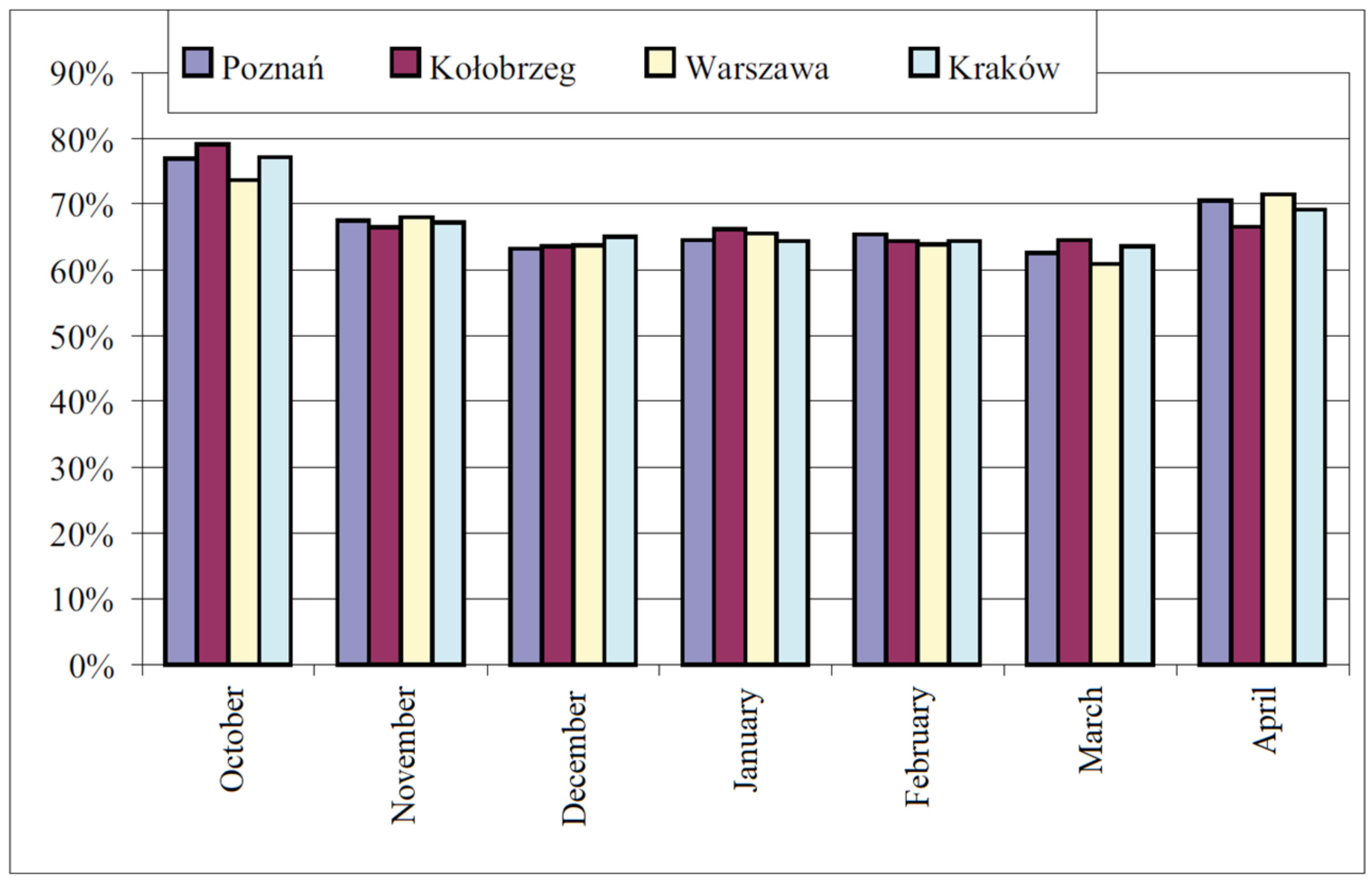
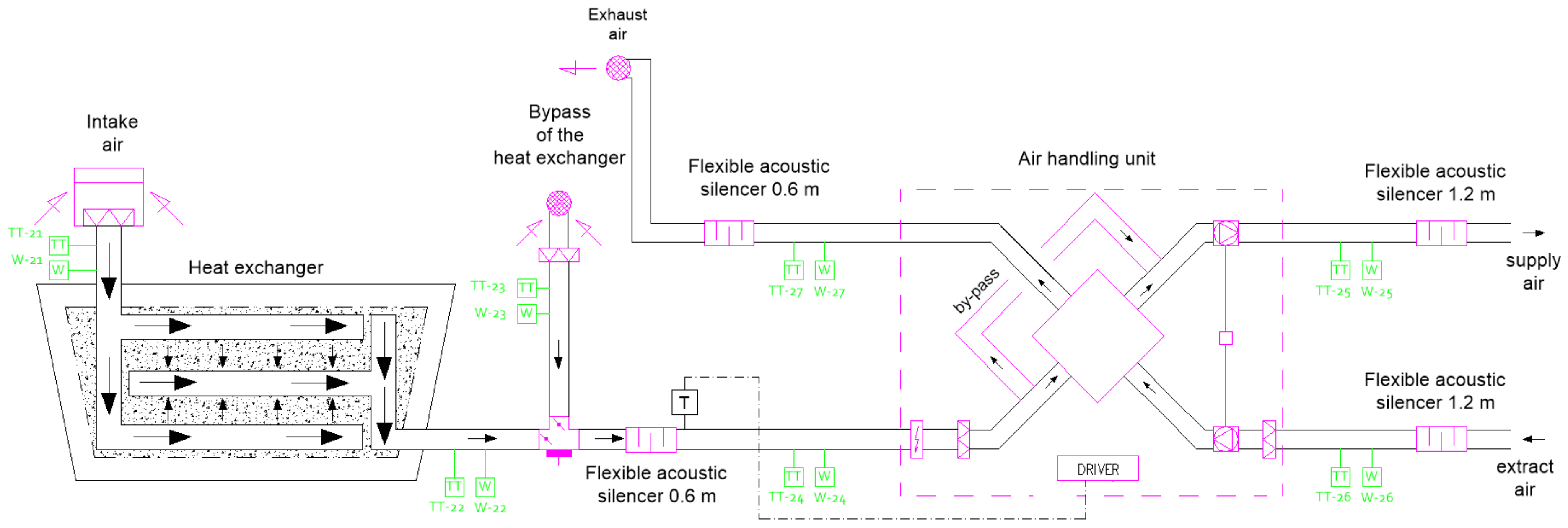
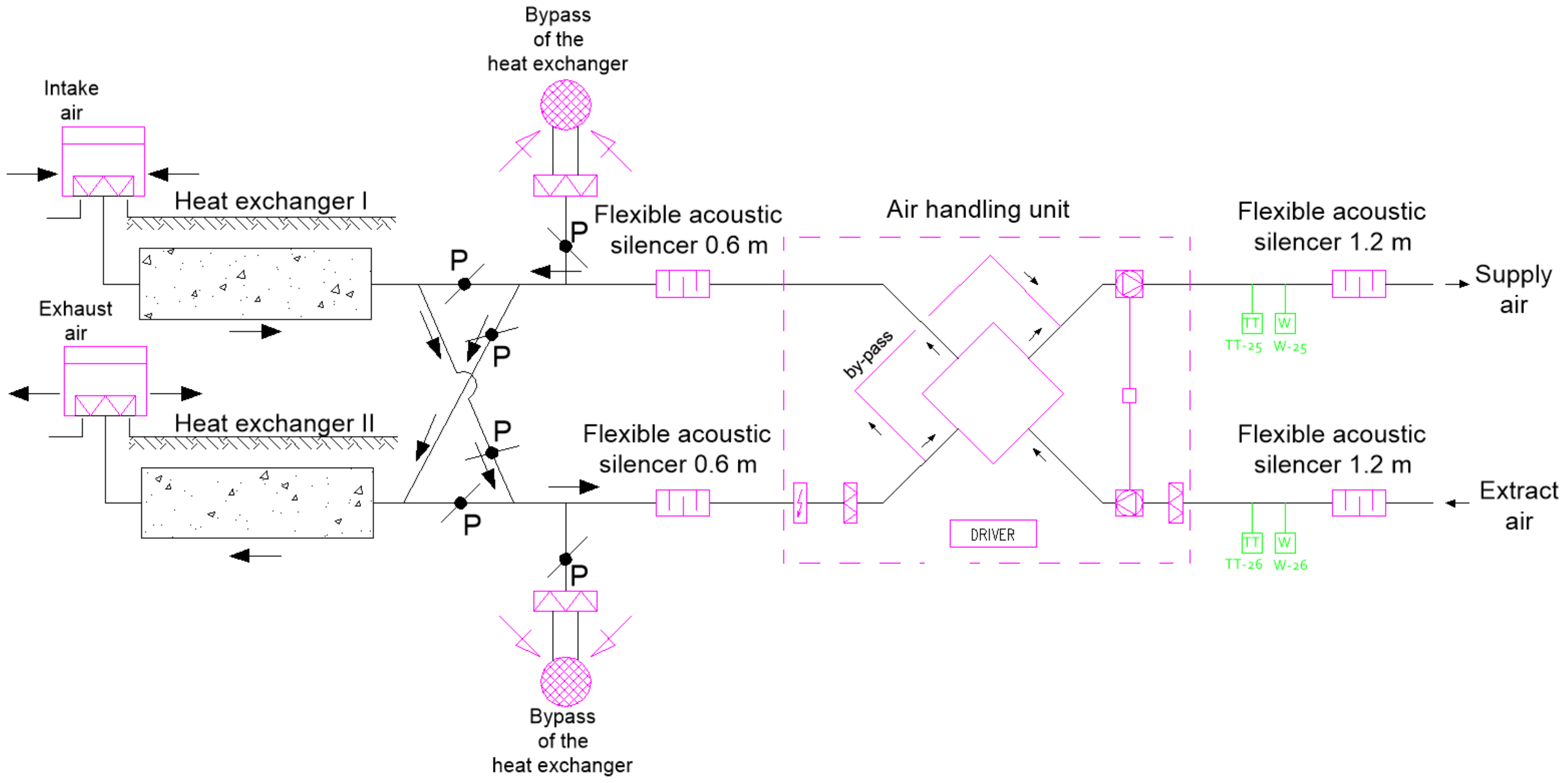
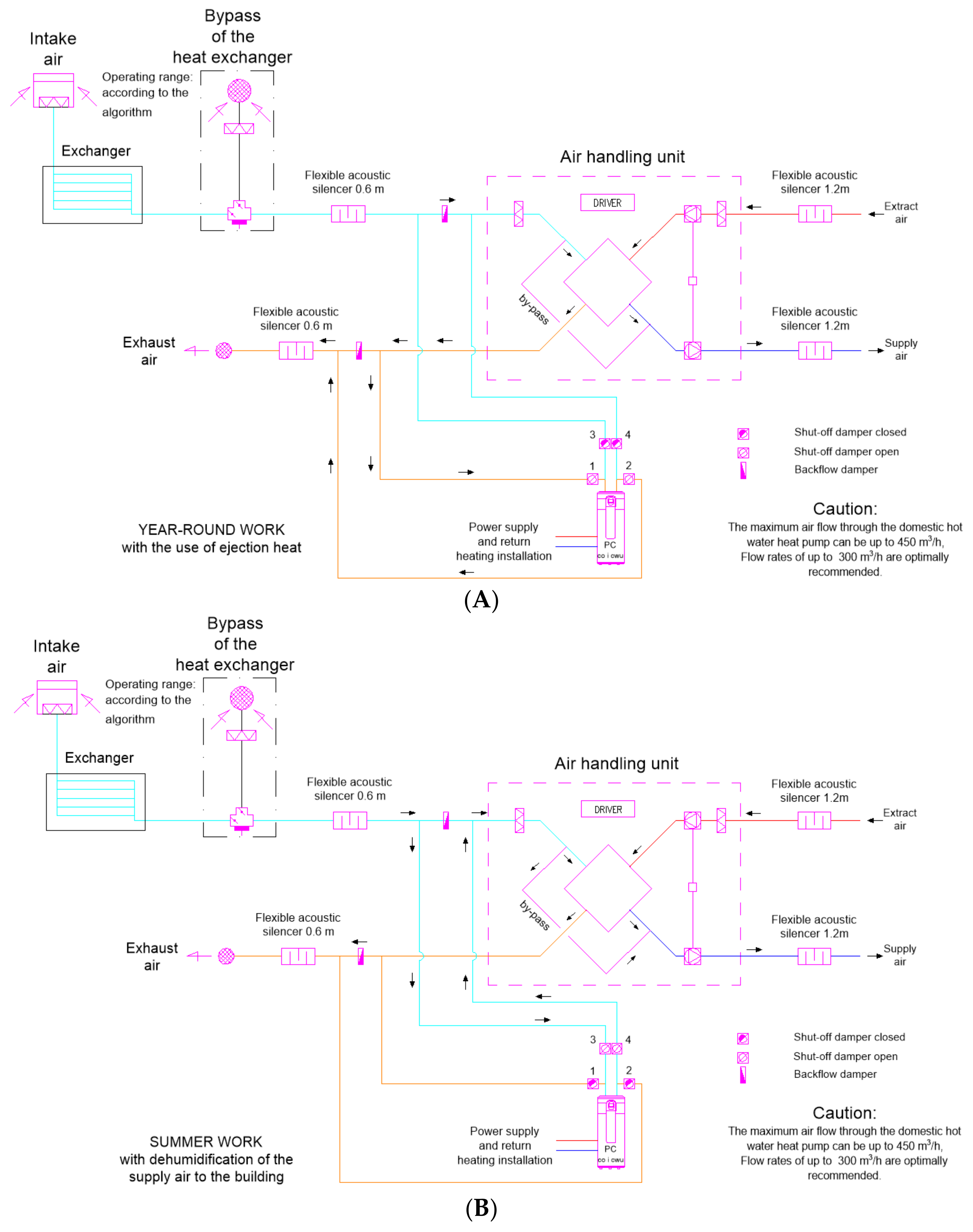
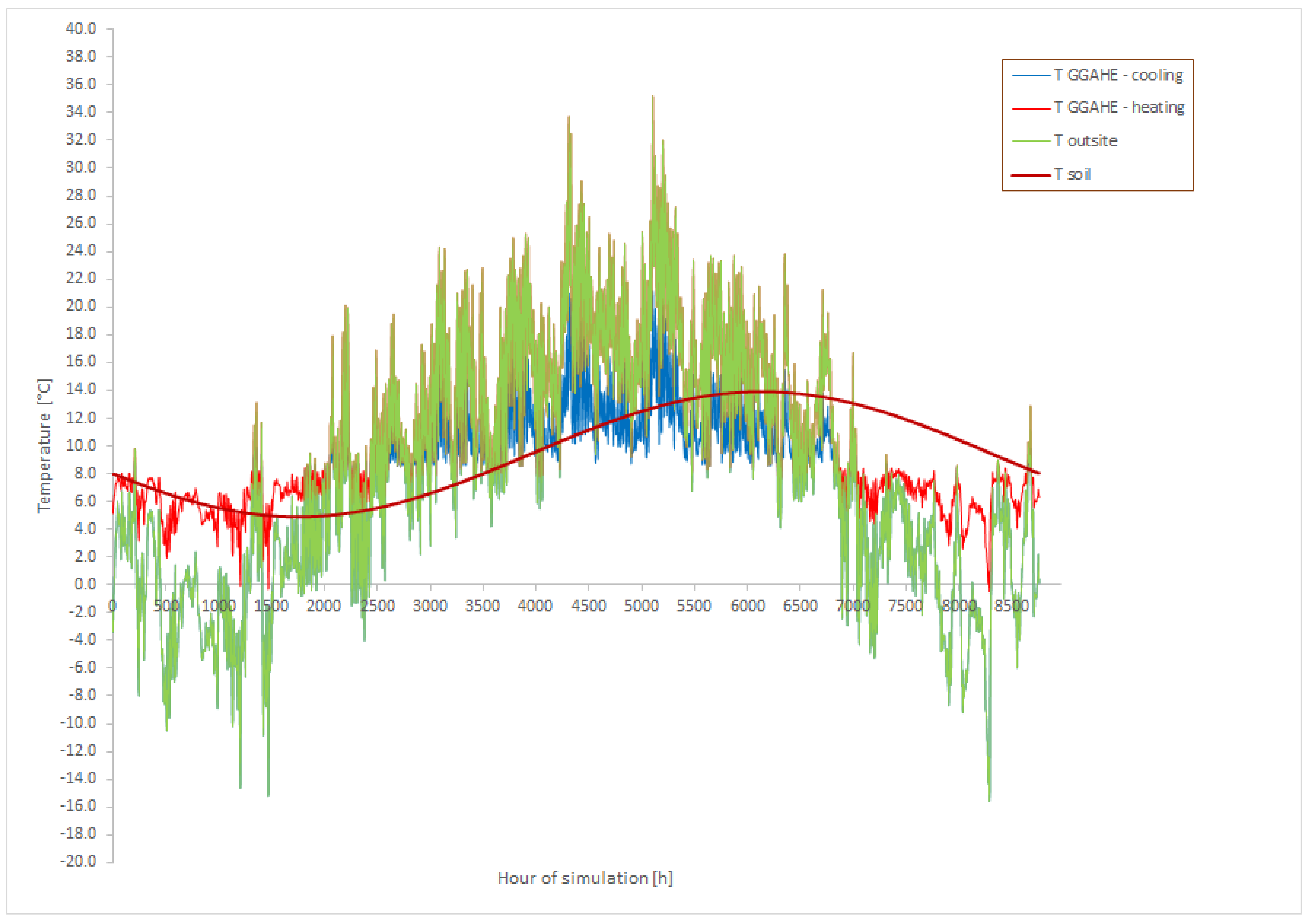
| Results Concerning Ground, Air–Ground, Gravel Heat Exchanger | ||
|---|---|---|
| Amount of heat taken from the ground during the heating period (Tout < 10 °C) | 1609.4 | kWh/a |
| Amount of heat transferred to the ground during the heating period (Tout < 10 °C) | −20.9 | kWh/a |
| Amount of energy taken from the ground during the heating period (Tout < 10 °C) | 1956.1 | kWh/a |
| Amount of energy transferred to the ground during the heating period (Tout < 10 °C) | −23.7 | kWh/a |
| Amount of heat taken from the ground during the transitional periods (10 °C < Tout < 16 °C) | 0.0 | kWh/a |
| Amount of heat transferred to the ground during the transitional periods (10 °C < Tout < 16 °C) | −686.5 | kWh/a |
| Amount of energy input from the ground during the transitional periods (10 °C < Tout < 16 °C) | 0.2 | kWh/a |
| Amount of energy transferred to the ground during the transitional periods (10 °C < Tout < 16 °C) | −720.4 | kWh/a |
| Amount of heat taken from the ground during the cooling period (10 °C < Tout < 16 °C) | 0.0 | kWh/a |
| Amount of heat transferred to the ground during the cooling period (Tout > 16 °C) | −1677.5 | kWh/a |
| Amount of energy taken from the ground during the cooling period (Tout > 16 °C) | 0.0 | kWh/a |
| Amount of energy transferred to the ground during the cooling season (Tout > 16 °C) | −2177.8 | kWh/a |
| Results of the Heat Input/Output to the Supply Air | |||
|---|---|---|---|
| GGAHE | Without GGAHE | ||
| Amount of heat obtained in the heating period (Tout < 10 °C) mechanical ventilation system with heat recovery | 5788.0 | 5634.9 | kWh/a |
| Heat output during the cooling period (Tout > 16 °C) mechanical ventilation system with heat recovery | −1677.5 | 0.0 | kWh/a |
| Heat quantities needed to heat the supply air to a building in the heating season (Tout < 10 °C) | 572.7 | 725.8 | kWh/a |
| Heat quantities needed for the electric heater to pre-heat the intake air | 0.0 | 312.66 | kWh/a |
| Amount of electricity used by the electric heater to pre-heat the intake air | 0.0 | 329.12 | kWh/a |
| Results of Intake Air Humidification | |||
|---|---|---|---|
| GGAHE | Without GGAHE | ||
| Amount of water abstracted from the ground during the heating period (Tout < 10 °C) | 488.5 | 0.0 | kg/a |
| Amount of energy taken from the ground to be humidified during the heating period (Tout < 10 °C) | 346.6 | 0.0 | kWh/a |
| Amount of electricity for humidifier purposes in the heating period (Tout < 10 °C) | 0.0 | 358.5 | kWh/a |
| Maximum amount of water abstracted from the ground during the heating period (Tout < 10 °C) | 0.65 | 0.0 | kg/h |
| Maximum electric power of the humidifier | 0.0 | 0.48 | kW |
| Results of the Dehumidification of Intake Air | |||
| GGAHE | Without GGAHE | ||
| Amount of water released to the ground during the cooling season (Tout > 16 °C) | −723.5 | 0.0 | kg/a |
| Amount of energy released to the ground during the cooling season (Tout > 16 °C) | −500.2 | 0.0 | kWh/a |
| Amount of electricity for the dehumidifier in the refrigeration period (Tout > 16 °C) | 0.0 | 1067.7 | kWh/a |
| Maximum amount of water released to the ground during the cooling season (Tout > 16 °C) | −2.40 | 0.0 | kg/h |
| Maximum electrical power of the dehumidifier | 0.0 | 3.55 | kW |
| Results Concerning the Amount of Electricity | |||
|---|---|---|---|
| GGAHE | Without GGAHE | ||
| Electricity consumption of the air-handling unit | 833.1 | 721.2 | kWh/a |
| Electrical energy consumption for heating the air during the heating period (Tout < 10 °C) | 148.7 | 188.5 | kWh/a |
| Electrical energy consumption for electric pre-heater air during the heating period (Tout < 10 °C) | 0.0 | 329.12 | kWh/a |
| Electrical energy consumption for humidifying air during the heating period (Tout < 10 °C) | 0.0 | 358.5 | kWh/a |
| Electrical energy consumption for cooling the air during the cooling period (Tout > 16 °C) | 0.0 | 559.2 | kWh/a |
| Electrical energy consumption for air dehumidification during the cooling period (Tout > 16 °C) | 0.0 | 1067.7 | kWh/a |
| Total electricity consumption | 981.82 | 3224.18 | kWh/a |
| Economic analysis | |||
| GGAHE | Without GGAHE | ||
| Variable system operating costs | 117.39 | 385.50 | euro/a |
| Additional investment costs | 1520.00 | 540.00 | euro |
| Simple payback time | 3.66 | a | |
| Ecological analysis | |||
| GGAHE | Without GGAHE | ||
| CO2 emissions to the environment | 783.49 | 2572.89 | kg CO2/a |
| Reduction of CO2 emissions to the environment | 1789.40 | kg CO2/a | |
Publisher’s Note: MDPI stays neutral with regard to jurisdictional claims in published maps and institutional affiliations. |
© 2022 by the authors. Licensee MDPI, Basel, Switzerland. This article is an open access article distributed under the terms and conditions of the Creative Commons Attribution (CC BY) license (https://creativecommons.org/licenses/by/4.0/).
Share and Cite
Radomski, B.; Kowalski, F.; Mróz, T. The Direct-Contact Gravel, Ground, Air Heat Exchanger—Application in Single-Family Residential Passive Buildings. Energies 2022, 15, 6110. https://doi.org/10.3390/en15176110
Radomski B, Kowalski F, Mróz T. The Direct-Contact Gravel, Ground, Air Heat Exchanger—Application in Single-Family Residential Passive Buildings. Energies. 2022; 15(17):6110. https://doi.org/10.3390/en15176110
Chicago/Turabian StyleRadomski, Bartosz, Franciszek Kowalski, and Tomasz Mróz. 2022. "The Direct-Contact Gravel, Ground, Air Heat Exchanger—Application in Single-Family Residential Passive Buildings" Energies 15, no. 17: 6110. https://doi.org/10.3390/en15176110
APA StyleRadomski, B., Kowalski, F., & Mróz, T. (2022). The Direct-Contact Gravel, Ground, Air Heat Exchanger—Application in Single-Family Residential Passive Buildings. Energies, 15(17), 6110. https://doi.org/10.3390/en15176110







